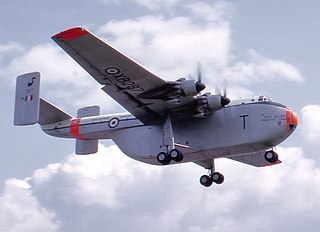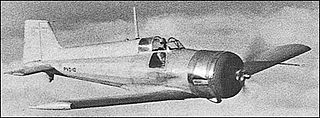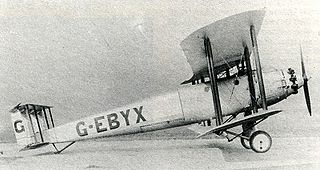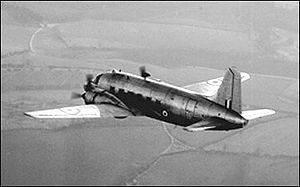
The Vickers VC10 is a mid-sized, narrow-body long-range British jet airliner designed and built by Vickers-Armstrongs (Aircraft) Ltd and first flown at Brooklands, Surrey, in 1962. The airliner was designed to operate on long-distance routes from the shorter runways of the era and commanded excellent hot and high performance for operations from African airports. The performance of the VC10 was such that it achieved the fastest crossing of the Atlantic by a subsonic jet airliner of 5 hours and 1 minute, a record that was held for 41 years, until February 2020 when a British Airways Boeing 747 broke the record at 4 hours 56 minutes due to Storm Ciara. Only the supersonic Concorde was faster. The VC10 is often compared to the larger Soviet Ilyushin Il-62, the two types being the only airliners to use a rear-engined quad layout. The smaller business jet Lockheed JetStar also has this engine arrangement.

The Vickers Vanguard was a short/medium-range turboprop airliner designed and produced by the British aircraft manufacturer Vickers-Armstrongs.

The Vickers Vimy was a British heavy bomber aircraft developed and manufactured by Vickers Limited. Developed during the latter stages of the First World War to equip the Royal Flying Corps (RFC), the Vimy was designed by Reginald Kirshaw "Rex" Pierson, Vickers' chief designer.

The Vickers Wellesley was a medium bomber that was designed and produced by the British aircraft manufacturer Vickers-Armstrongs at Brooklands near Weybridge, Surrey. It was one of two aircraft to be named after Arthur Wellesley, 1st Duke of Wellington, the other being the Vickers Wellington.

The Handley Page HP.67 Hastings is a retired British troop-carrier and freight transport aircraft designed and manufactured by aviation company Handley Page for the Royal Air Force (RAF). Upon its introduction to service during September 1948, the Hastings was the largest transport plane ever designed for the service.

The Armstrong Whitworth Argosy was a British post-war transport/cargo aircraft; it was the final aircraft to be designed and produced by aviation company Armstrong Whitworth Aircraft. Although given different internal design numbers, the AW.650 civil and AW.660 military models were, for most practical purposes, the same design, while both models also shared the "Argosy" name.

The Vickers VC.1 Viking is a British twin-engine short-range airliner derived from the Vickers Wellington bomber and built by Vickers-Armstrongs Limited at Brooklands near Weybridge in Surrey. After the Second World War, the Viking was an important airliner with British airlines, pending the development of turboprop aircraft like the Viscount. An experimental airframe was fitted with Rolls-Royce Nene turbojets and first flown in 1948 as the world's first pure jet transport aircraft. Military developments were the Vickers Valetta and the Vickers Varsity.

The Vickers Viking was a British single-engine amphibious aircraft designed for military use shortly after World War I. Later versions of the aircraft were known as the Vickers Vulture and Vickers Vanellus.

The Vickers Type 56 Victoria was a British biplane freighter and troop transport aircraft used by the Royal Air Force. The Victoria flew for the first time in 1922 and was selected for production over the Armstrong Whitworth Awana.

The Blackburn B-101 Beverley was a heavy transport aircraft produced by the British aircraft manufacturer Blackburn Aircraft. It was notably the only land-based transport airplane built by Blackburn, a company that otherwise specialised in producing naval fighter aircraft.

The Vickers Varsity is a retired British twin-engined crew trainer operated by the Royal Air Force from 1951 to 1976.

The Short SA.4 Sperrin was a British jet bomber design of the early 1950s, built by Short Brothers and Harland of Belfast. It first flew in 1951. From the onset, the design had been viewed as a fall-back option in case the more advanced strategic bomber aircraft, then in development to equip the Royal Air Force's nuclear-armed V bomber force, experienced delays; the Sperrin was not put into production because these swept-wing designs, such as the Vickers Valiant, were by then available.
The North East Land, Sea and Air Museums (NELSAM), formerly the North East Aircraft Museum, is a volunteer-run aviation museum situated on the site of the former RAF Usworth/Sunderland Airport, between Washington and Sunderland, in Tyne and Wear, England. The museum has the largest aviation collection between Yorkshire and Scotland and houses over 30 aircraft and a wide collection of aero engines. The museum also has a small collection of other items such as weaponry, vehicles and other historical exhibits.
Captain Joseph "Mutt" Summers, was chief test pilot at Vickers-Armstrongs and Supermarine.

The Vickers Type 279 Venom was a British low-wing monoplane single-seat, single-engined, eight-gun fighter aircraft. It was fast and manoeuvrable but its Bristol Aquila radial engine was underpowered. Together with other designs built to the same specification, which included the Bristol Type 146, Gloster F.5/34, and Martin-Baker MB 2, it was rejected by the Air Ministry and only one Venom was built.

The Vickers Vellore was a large biplane designed as a freight and mail carrier, in single-engined and twin-engined versions, which saw limited use as freighters and long-range experimental aircraft. A final variant with a broader fuselage, the Vellox, was built as an airliner.

The Vickers Type 151 Jockey was an experimental low-wing monoplane interceptor fighter powered by a radial engine. It was later modified into the Type 171 Jockey II, which had a more powerful engine and detail improvements. Only one was built; it was lost before its development was complete, but the knowledge gained enabled Vickers to produce the more refined Venom.

The Vickers Type 253 was a single-engined two-seat biplane general-purpose military machine built to a 1930 government specification. It won a production contract, but this was transferred to the same company's monoplane equivalent, the Wellesley. Only one Type 253 was built.

On 6 January 1954 WJ474 a twin-engined Vickers Valetta training aircraft of No. 2 Air Navigation School Royal Air Force crashed near RAF Bovingdon just after takeoff in bad weather.

On 15 January 1953, a twin-engined Vickers Valetta transport aircraft of the Royal Air Force (RAF), serial number VX562, collided over the Mediterranean Sea with a four-engined RAF Avro Lancaster maritime patrol aircraft. All 26 people on board both aircraft were killed.





















